Pseuduvaria galeata is a species of plant in the family Annonaceae. It is a tree endemic to Peninsular Malaysia. James Sinclair, the Scottish botanist who first formally described the species, named it after the dome formed by inner petals shaped like a helmet.
Pseuduvaria taipingensis is a species of plant in the family Annonaceae. It is a tree endemic to Peninsular Malaysia. James Sinclair, the Scottish botanist who first formally described the species, named it after Taiping a city in Perak, Malaysia where the specimen he examined was collected.
Pseuduvaria clemensiae is a species of plant in the family Annonaceae. It is native to New Guinea. Yvonne Chuan Fang Su and Richard M.K. Saunders, the botanists who first formally described the species, named it after Mary Strong Clemens who collected the specimen they examined.
Pseuduvaria coriacea is a species of plant in the family Annonaceae. It is native to New Guinea. Yvonne Chuan Fang Su and Richard M.K. Saunders, the botanists who first formally described the species, named it after its leathery leaves.
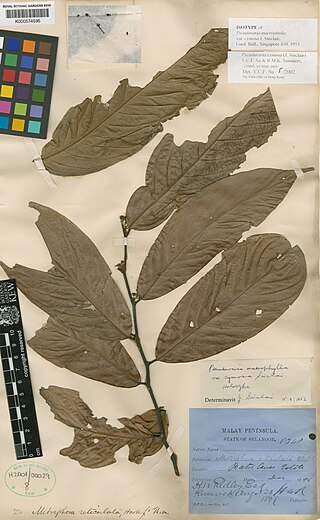
Pseuduvaria cymosa is a species of plant in the family Annonaceae. It is native to Peninsular Malaysia. James Sinclair, the Scottish botanist who first formally described the species using the synonym Pseuduvaria macrophylla var. cymosa, named it after its branched inflorescences which are called cymes.
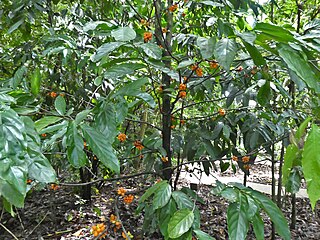
Pseuduvaria froggattii is a rare species of tree which is restricted to a very small part of northeastern Queensland, Australia. It is a member of the custard apple and soursop family Annonaceae, and was first described in 1887. Despite the small range its status considered to be least concern.
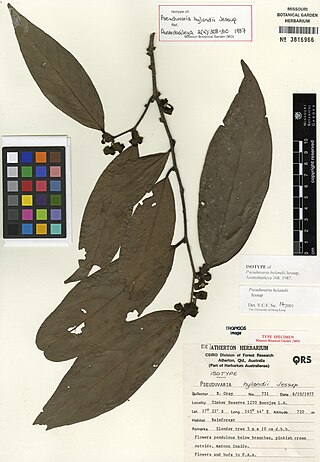
Pseuduvaria hylandii is a species of plant in the family Annonaceae. It is native to Australia. L.W. Jessup, the botanists who first formally described the species, named it after Bernard Hyland an Australian botanist who collected the specimen he examined.
Pseuduvaria kingiana is a species of plant in the family Annonaceae. It is native to the Malay Peninsula. Yvonne Chuan Fang Su and Richard Saunders, the botanists who first formally described the species, named it after Sir George King, the British botanist who first collected the species.

Pseuduvaria luzonensis is a species of plant in the family Annonaceae. It is native to The Philippines. Elmer Drew Merrill, the American botanist who first formally described the species using the synonym Orophea luzoniensis, named it after Luzon in the province of Battan, Philippines where the specimen he examined was collected along the Lamao River.
Pseuduvaria macgregorii is a species of plant in the family Annonaceae. It is native to The Philippines. Elmer Drew Merrill, the American botanist who first formally described the species, named it after Richard MacGregor the Australian ornithologist and plant collector who collected the specimen Merrill examined.
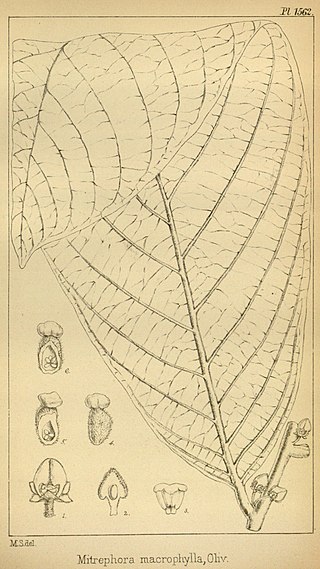
Pseuduvaria macrophylla is a species of plant in the family Annonaceae. It is native to Peninsular Malaysia, Sumatra and Thailand. Daniel Oliver, the English botanists who first formally described the species using the synonym Mitrephora macrophylla, named it after its large leaves.
Pseuduvaria mindorensis is a species of plant in the family Annonaceae. It is native to the Philippines. Yvonne Su and Richard Saunders, the botanists who first formally described the species, named it after the island of Mindoro where the specimen they examined was collected in the municipality of Puerto Galera.
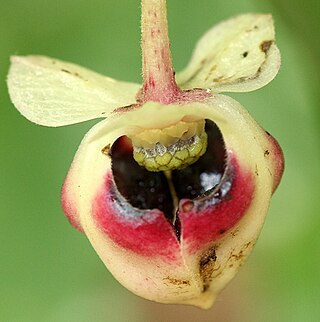
Pseuduvaria mulgraveana is a species of plant in the family Annonaceae endemic to Queensland, Australia. L.W. Jessup, the botanist who first formally described the species, named it after the Mulgrave River, where the specimen he examined was collected.
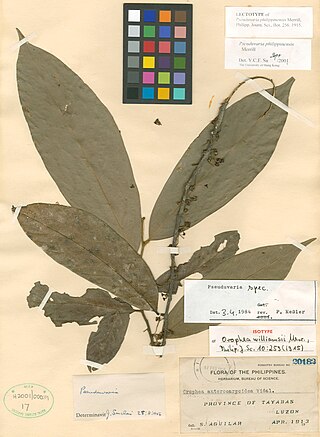
Pseuduvaria philippinensis is a species of plant in the family Annonaceae. It is native to the Philippines. Elmer Drew Merrill, the botanist who first formally described the species, named it after the Philippines where the specimen he examined was collected in the Province of Quezon.
Pseuduvaria pulchella is a species of plant in the family Annonaceae. It is native to New Guinea. Ludwig Diels, the botanist who first formally described the species using the basionym Orophea pulchella, chose a specific epithet that means “beautiful little” in Latin, but he did not specify to which aspect of the plant he was referring.

Pseuduvaria reticulata is a species of plant in the family Annonaceae. It is native to Bangladesh, Borneo, Java, the Lesser Sunda Islands, Myanmar and Sumatra. Carl Ludwig Blume, the botanist who first formally described the species under the basionym Uvaria reticulata, named it after the net-like pattern of veins on the underside of its leaves.

Pseuduvaria rugosa is a species of plant in the family Annonaceae. It is native to Java, Laos, the Lesser Sunda Islands, Peninsular Malaysia, Myanmar, the Nicobar Islands, Sumatra and Thailand. Carl Ludwig Blume, the botanist who first formally described the species under the basionym Uvaria rugosa, named it after its wrinkled fruit.
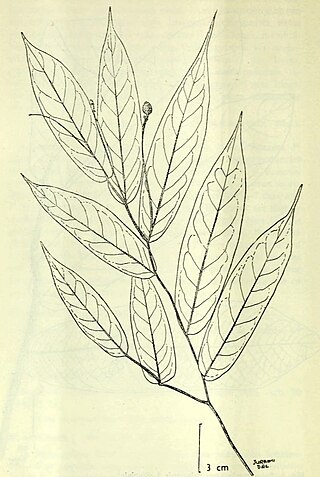
Pseuduvaria sessilifolia is a species of plant in the family Annonaceae. It is native to New Guinea. James Sinclair, the botanist who first formally described the species, named it after its stalkless leaves which lack petioles.

Pseuduvaria unguiculata is a species of plant in the family Annonaceae. It is endemic to The Philippines. Adolph Daniel Edward Elmer, the American botanist who first formally described the species, named it after its clawed inner petals.

Pseuduvaria villosa is a species of plant in the family Annonaceae. It is endemic to Australia. L.W. Jessup, the botanist who first formally described the species, named it after its leaves and branchlets which are shaggy with long soft hairs.












